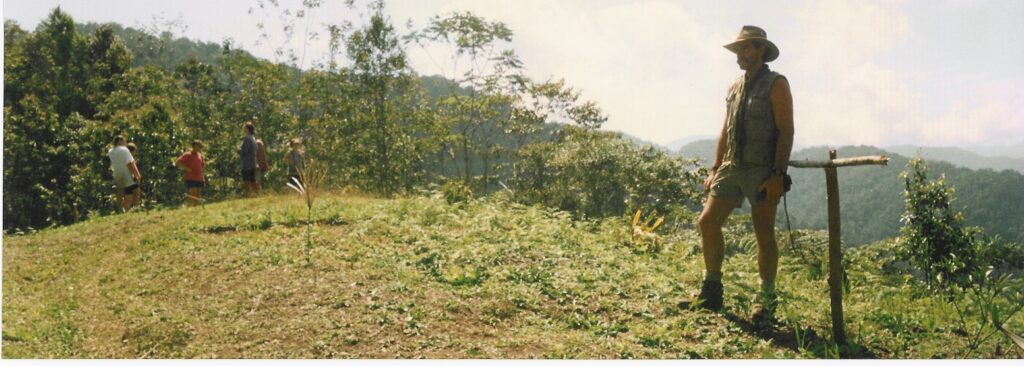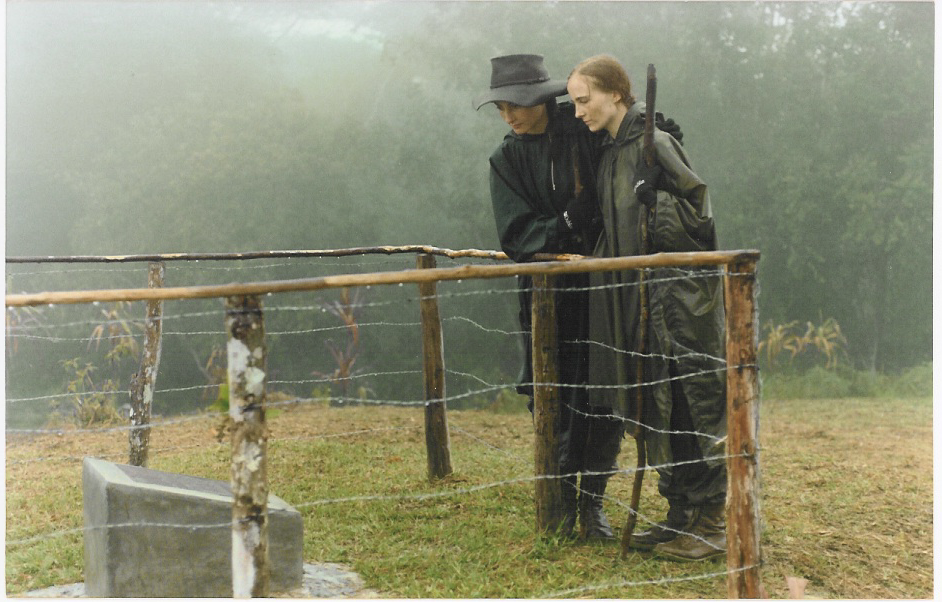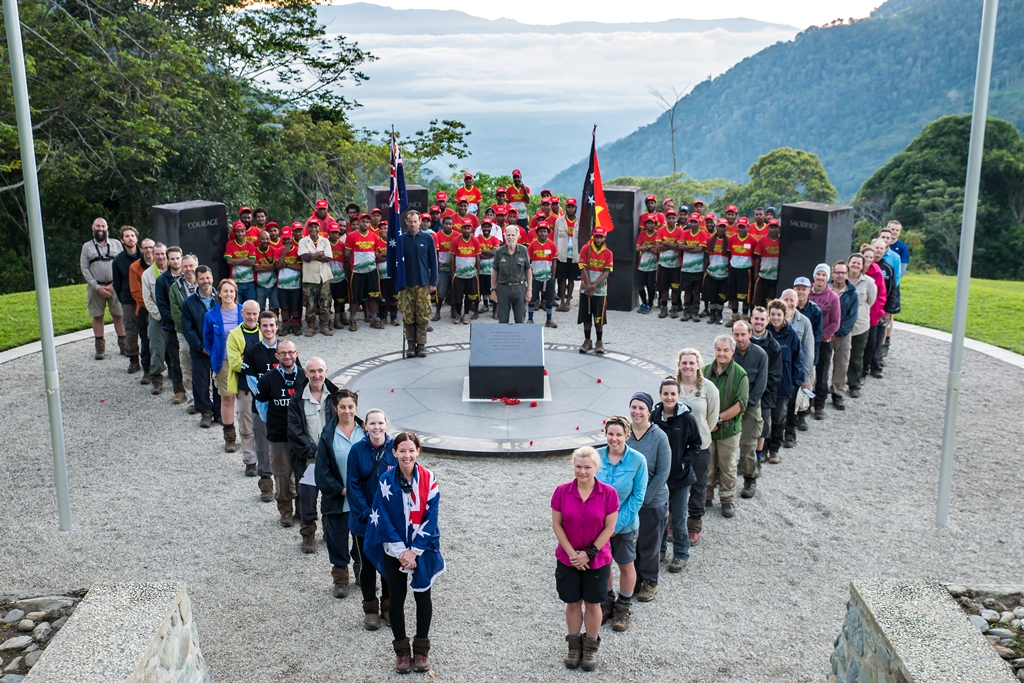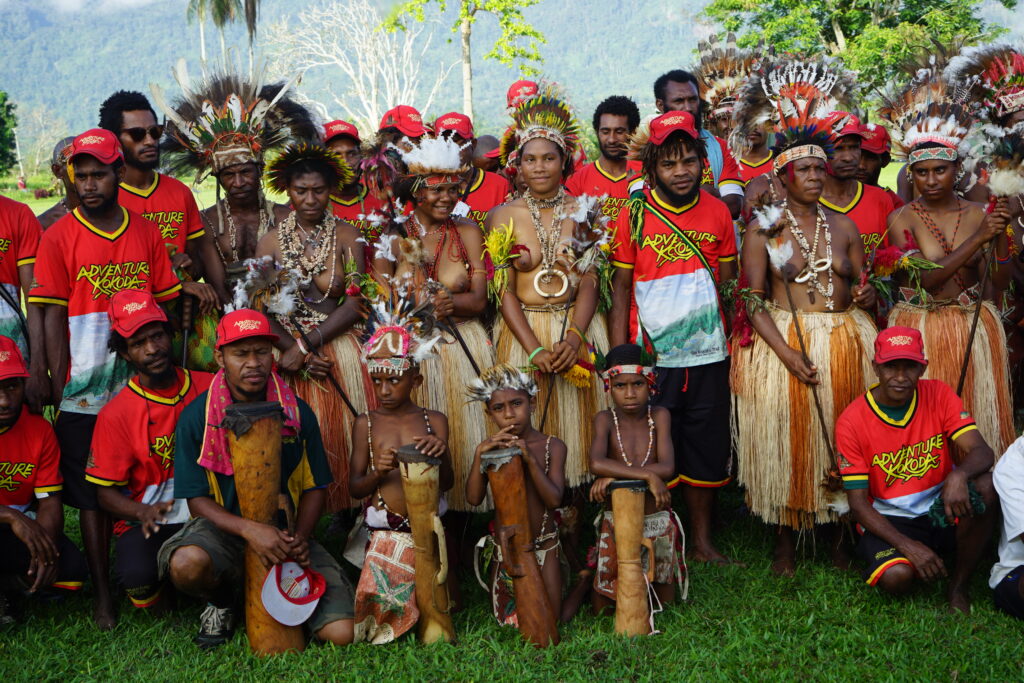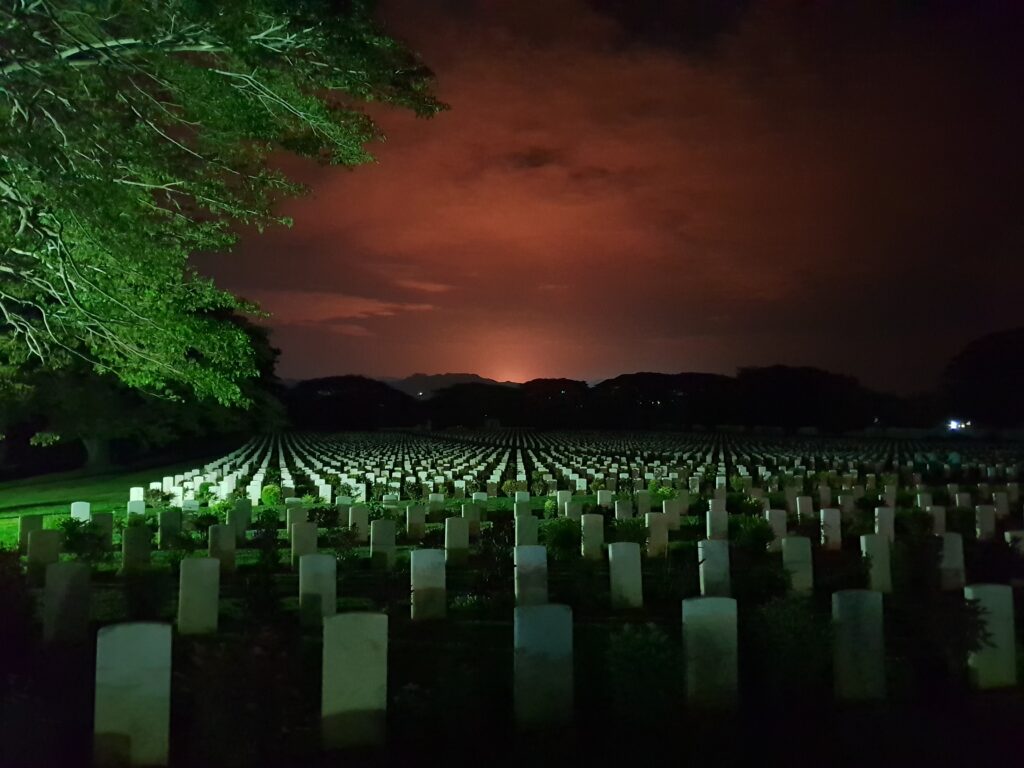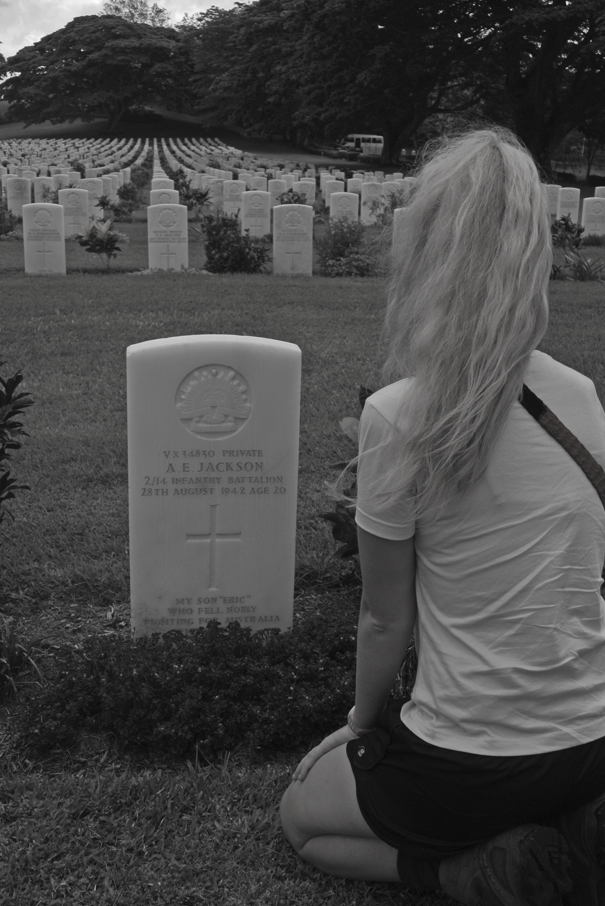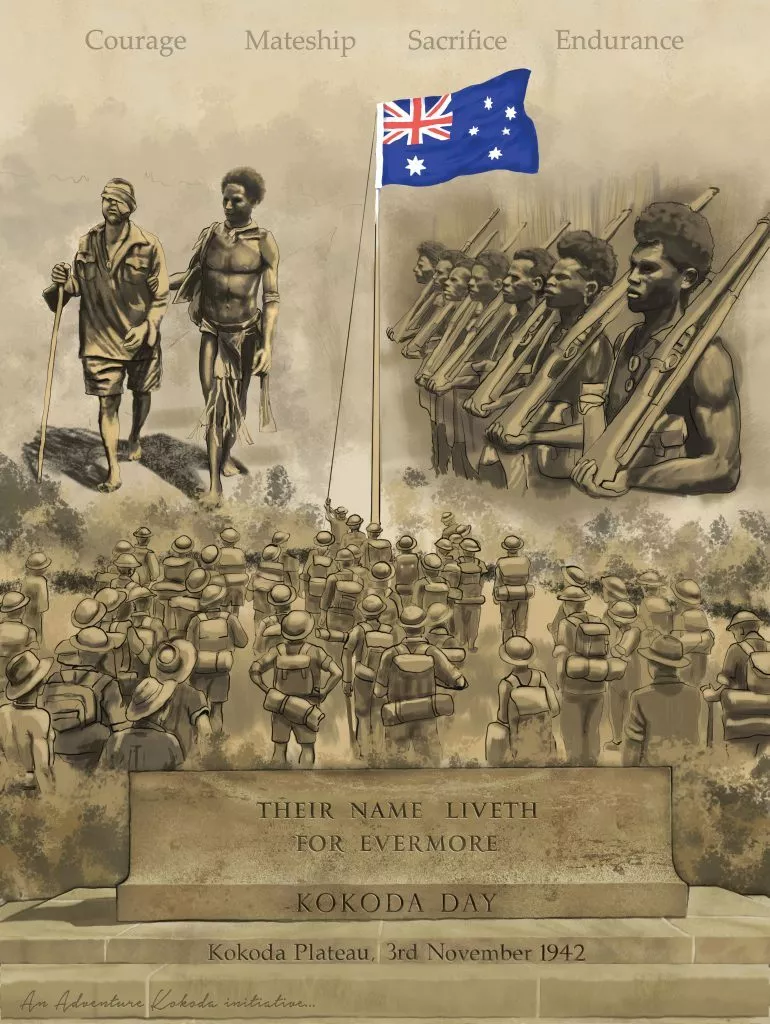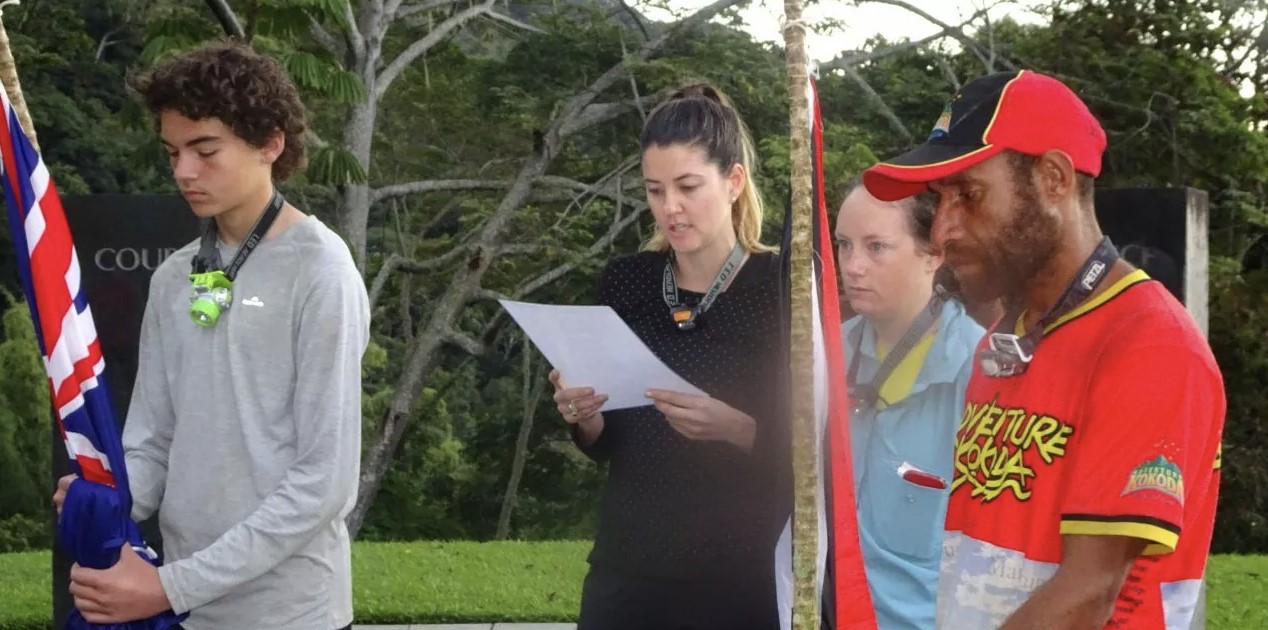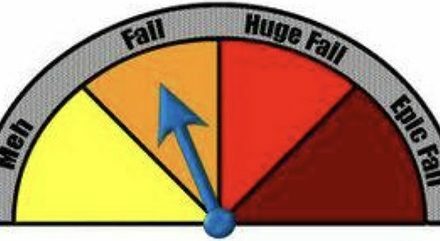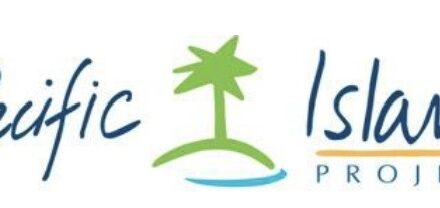This content has been archived. It may no longer be relevant
The Kokoda Trail
‘Just a day’s travel from Sydney, Melbourne or Brisbane and you can be on the Kokoda Trail.
Michael pender – military heritage architect
‘At the foot of the Owen Stanley Ranges in Papua New Guinea you can look into the ancient landscape – majestic peaceful wilderness, nature in its full glory.
‘‘There have been tracks across the mountains for thousands of years – the people who inhabit the region were gardening at the same time agriculture was developing in Ancient Egypt. The strength of natural and cultural heritage are beyond simple words; fascinating, awesome, daunting – world class.
‘Yet the battles of 1942 and the contemporary interest in ‘Kokoda’ are what have made it Papua New Guinea’s No.1 tourist attraction.
‘In 1942 it was Australians and Papua New Guineans fighting Japanese for what was then Australian land. Young men in a bloody struggle for ‘their land’. The battle has become folklore in Australia – a place of pilgrimage like Gallipoli, Villers-Bretonneux, Sandakan, Passchendaele.’[i]
More than 65,000 Australians from all walks of life and political persuasions have experienced the pilgrimage across the Kokoda Trail since the 50th anniversary of the campaign in 1992.
It has emerged as the complete adventure experience for boomers and young adventurers. It requires physical stamina and mental tenacity. The wartime history evokes strong emotions. The unconditional care and support of local PNG guides and villagers is humbling. The environment is rugged, remote, and pristine.
But equally important is a desire for a brief escape from the intrusion of government and social media into the bustle of our daily lives.
These motivations are identified in a recent book, ‘Pilgrimage – Journeys of Meaning[ii]’ which provide an insight into the potential of wartime tourism in the modern world and the paradox of pilgrimage.
‘Why in our otherwise markedly secular and sceptical times, especially in the developed world where numbers of those who describe themselves as religious is in rapid decline, are people actively seeking out places whose history is soaked in the sort of faith that is anathema to them?’
The author concludes:
‘The standard answer I was given many times is that tourism is the new religion, and that pilgrimage just a new name for tourism.
‘For pilgrimage read adventure holiday, and for pilgrim read hiker.
‘Pilgrimage is a word that should be used with care, not thrown around lightly in glossy travel brochures. It signals more than a ramble through foreign countryside with friends more than a chance to get healthy and do some sight-seeing into the bargain.‘Walking along a pilgrim road opens us to a legacy that reaches beyond firmer muscles and toned bodies. Significant numbers of those who walk the Camino[iii], and who are among the more than 50 percent of them who disclaim the label of religious, nonetheless talk of how the experience leaves them changed.
‘Pilgrimage, past and present, has to be seen as a sub-section of a bigger and even longer human impulse that might be called ‘walking with a purpose’.
‘Today that has been amended. The effort of 21st century pilgrimage directs thoughts inwards, as mountains are climbed, kilometres clocked up and blisters endured. Everything is done at walking pace, in contrast to a world that, now more than ever, is ceaselessly rushing ahead faster that we can quite compute. So, on pilgrimage progress can also be measured in self-exploration and self-knowledge.‘
There are many roads, but pilgrimage is less extreme, more mainstream, than many – though it is still quirky enough to raise an eyebrow. ‘You! Going on pilgrimage? I’d never have suspected.’ With its long history, and extraordinary spiritual geography, it continues to lend itself to the search for meaning.’
Author, Brett Caldwell, captures the contradiction of modern and ancient cultures within a ‘Parliament of a Thousand Tribes’[iv] in his PNG memoir ‘Indifference’[v]:
‘Paradox prevails. It is a land where arse-grass and penis gourds mix with Hugo Boss suits and Rolex watches; where some men mine the hearts of volcanoes for gold, while others worship the spirits of ancestral crocodiles. It is a place where ferociously decorated warriors battle over women, land and pigs, with stout bows and homemade shotguns; where Asian loggers plunder ancient forests alongside Christian missionaries harvesting souls, and where Australian government bureaucrats try to impose their antipodean canons upon a culture where blood and bribery are thicker than holy water.’
The ‘Search for Meaning’
Papua New Guinea, the custodian of land sacred to the shared military heritage for pilgrims from Australia, Japan, and the United States. lends itself to such a ‘search for meaning’.
A niche wartime pilgrimage tourism industry beckons beyond the Kokoda Trail to Rabaul, Milne Bay, Bougainville, Buna-Gona-Sananda, Shaggy Ridge, Black Cat Track, the Lark Force Track, the Numa- Numa Track, the Kapa-Kapa Track, the Markham Valley, Nadzab, Lae, Finchafen, the Ramu Valley and Finisterre Ranges.
These are not only different campaigns and battlesites – they are inhabited by different cultures with different traditions that create a smorgasbord of adventure based opportunities.
Wartime tourism leads people off the beaten track to remote areas where traditional societies rely on subsistence agriculture to survive on a day-to-day basis. They live with interesting rituals and meet strangers with a suspicious but warm curiosity.
Pilgrimage tourism is not restricted to trekkers. It has the capacity for wartime cruises to Port Moresby, Milne Bay, Lae, Madang, Wewak, Aitape, Manus, Rabaul, Bougainville, and Guadalcanal in the Solomon’s.
Those who venture beyond the potpourri of cultures in shanty settlements around the nation’s capital in Port Moresby are soon captured by the simple warmth, innocence, and humble curiosity of subsistence village cultures.
But beneath the surface in remote villages are complex relationships between the lululais’ (village chiefs), religious pastors, one or more sorcerers, and several clan leaders.
These relationships are further complicated when a template comprising more than 850 languages is superimposed over the island. Seafaring coastal Papuans, Sepiks, mountain Koiari, highlanders, lowlanders, grasslanders and islanders with a myriad of sub-groups with strong bonds of mutual obligation the western mind will never understand.
Today, the Kokoda Trail is the gateway to this smorgasbord of authentic cultural-heritage-environmental pilgrimages. It truly is the ‘last adventure’ – and it’s on our doorstep!
Philanthropy
Pilgrimage tourists are invariably willing to leave a footprint behind in traditional societies to assist in meeting immediate health needs or educational development.
The challenge for PNG is to ensure contributions received are used for their intended purpose and that donors are kept appraised of the outcomes.
This requires an independent organisational structure with the authority to collect, distribute, monitor, and report on all philanthropic donations. A national strategy to develop legislation with strict governance protocols would ensure the potential of pilgrimage tourism is realised.
For example, if just 10% of the 65,000 Australians who have trekked Kokoda had agreed to donate the equivalent of a cappuccino each week towards a ‘Kokoda Philanthropic Trust’ it would now have an annual income of $650,000 (K1.7 million) per year to meet local health and education needs. The real figure would be much more than this as some of the most wealthy and influential Australians are among those who have trekked it.
Gallipoli – Kokoda
The most relevant guide to the potential of a wartime tourism industry in PNG is the continued growth of those making the annual pilgrimage to Gallipoli.
Each year up to 9000 Australians visit the Dawn Service at Anzac Cove – thousands more visit it at other times of the year. It is also emerging as a pilgrimage for more than a million Turkish people visiting Gallipoli each year.
Less than 3000 Australians visit the Anzac Dawn Service at Bomana War Cemetery which contains the remains of 3824 veterans – more than any other Australian war cemetery in the world.
This is despite the fact that PNG is closer, cheaper, and just as meaningful despite the fact that at Gallipoli we fought for Britain and lost, while at Kokoda we fought for Australia and won!
Imagine . . .
- an Anzac Dawn Service at Owers Corner; a showcase of PNG culture along Ela Beach; a sunset ‘Beating-of-the-Retreat’ at Bomana War Cemetery followed by a 7-day Pacific War Cruise to each of the significant coastal/island battlesites.
- a joint Anzac Dawn Service at Bomana War Cemetery with PNG students carrying stretchers out of the dawn mist through rows of polished marble headstones towards the Cross of Sacrifice to the beat of traditional kundu drums. Stretchers symbolizing the sacrifice of the legendary ‘fuzzy-wuzzy angels’ would then be laid gently on the ground while they formed a catafalque party around each one for the duration of the service. It would put goosebumps on the nation.
- an annual ‘Kokoda Day’ service to commemorate the raising of the Australian flag on the Kokoda plateau on 3rd November each year along with traditional Koiari and Orokaiva sing-sings and cultural dances.
If it’s to be – it’s up to PNG!
PNG tourism has had a free ride with the growth of Kokoda tourism which has happened in spite of them – not because of them!
The special purpose authority put in place to manage the Trail is hopelessly incompetent – Kokoda tourism numbers have plummeted under its watch due to mismanagement and corruption.
PNG is now the only country in the world to have its most popular tourism destination managed as an environment park for the benefit of foreign aid-funded officials rather than as a commercial enterprise for the economic benefit of traditional landowner communities.
This will not change until National Executive Council (NEC) transfers legal responsibility for the Kokoda Trail from the Minister for Provincial and Local-Level Government and from the aid-funded influence of the Minister for Environment, Conservation and Climate Change to the Minister for Tourism, Arts and Culture.
The opportunity for an effective wartime pilgrimage tourism policy will not be realized until this happens.
The rapid development of Kokoda tourism is worthy of a case study towards the development of such a policy – but first there needs to be an empathetic understanding of the values and needs of international tourists (i.e. the paying customers) relating to authenticity, safety, governance, and service efficiency.
This will require the appointment of a professional Board of Directors with qualifications in business, law, accounting, governance, and military heritage.
It will also require the recruitment of qualified managers in the fields of administration, accounting and field operations – see proposed organizational chart below:
Joint Agreement for Pilgrimage Tourism
The Joint Understanding for Papua New Guinea and Australia for the Kokoda Track and Owen Stanley Ranges signed between the two Ministers for Environment in Madang on 23 April 2008 provides a precedent for a similar agreement for wartime pilgrimage tourism.
A Joint Agreement for Pilgrimage based on the Principles of Commemoration should be considered between the Australian Minister for Veterans Affairs and the PNG Minister for Tourism, Arts, and Culture to ensure military sites sacred to our shared wartime heritage are identified, secured, mapped and interpreted.
Army-Military Heritage Cooperation
An Australian-Japan Research Project was established at the Australian War Memorial more than a decade ago. The project seeks to explore aspects of Australian and Japanese attitudes to the Pacific War using archival material held by the Australian War Memorial.
The recent upscaling of army cooperation between Australia and PNG in response to China’s expanding influence in the Pacific should include a strategy to identify, record, map and signpost significant battlesites of each campaign.
The Australian War Memorial could assist by developing an ‘Australian-PNG Project along similar lines to their Australia-Japan Project.
Reg Yates, a former Australian Army captain has explored all of the significant campaign sites throughout Papua New Guinea over a 40-year period and published ‘A Guide to Adventurous Training for ADF Personnel’. This could be used as a template for a detailed heritage plan of each site.
Small teams of Australian and PNG army officers could be assigned to each of the significant sites across the Kokoda Trail (Kokoda, Deniki, Isurava, Eora Creek, Templeton’s Crossing, Lake Myola, Brigade Hill and Ioribaiwa Ridge) to study the tactics of each battle then map and signpost each one. This would complement interpretive memorials which could later be developed as part of a Military Heritage Master Plan for the Kokoda campaign.
This model of research and development could then be replicated at other significant campaign sites throughout PNG.
Kokoda Trail Management Authority (KTMA)
The first step towards the effective management of pilgrimage tourism is the development of a management structure with qualified people and strict governance protocols at every level for each destination.
Following is a suggested structure for a Kokoda Trail Management Authority:
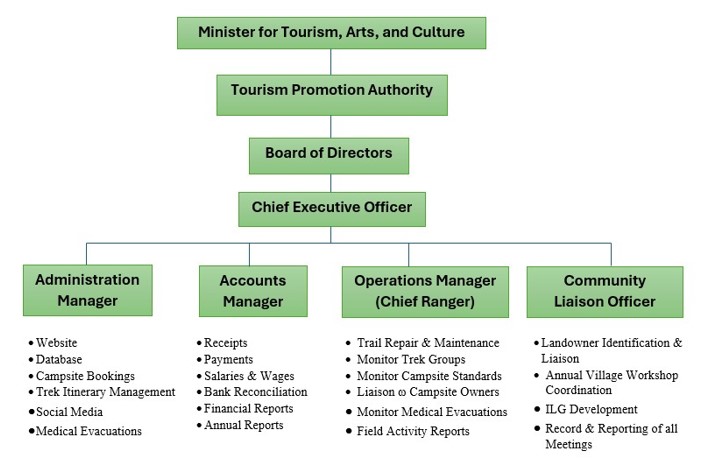
A Kokoda Trail Management Authority (KTMA) could be a precursor to the establishment of special purpose authorities to manage each particular area – the Kokoda Trail, the Lark Force Track, the Black Cat Track, The Numa-Numa Track; Shaggy Ridge and other significant wartime tourism destinations in Milne Bay, Rabaul, Buna-Gona and Sanananda.
National Pilgrimage Tourism Authority
A National Pilgrimage Tourism Authority (NPTA) in PNG would provide a national framework for such an industry.
The NPTA should be run as a commercial enterprise with profits returned for local community development.
Joint Agreements for Pilgrimage Tourism could be developed with governments from Australia, the United States and Japan to develop, fund and maintain interpretative memorials to honour the military heritage of each site. They would also contribute specialist personnel familiar with Melanesian culture and the necessary infrastructure to support access to such sites as the demand for pilgrimages develops.
The long-term benefits of pilgrimage tourism extend far beyond the tourism industry. These include the protection of our shared military heritage; a sustainable source of income for local landowner communities; and an empathetic gateway for a better understanding of our cultural differences.
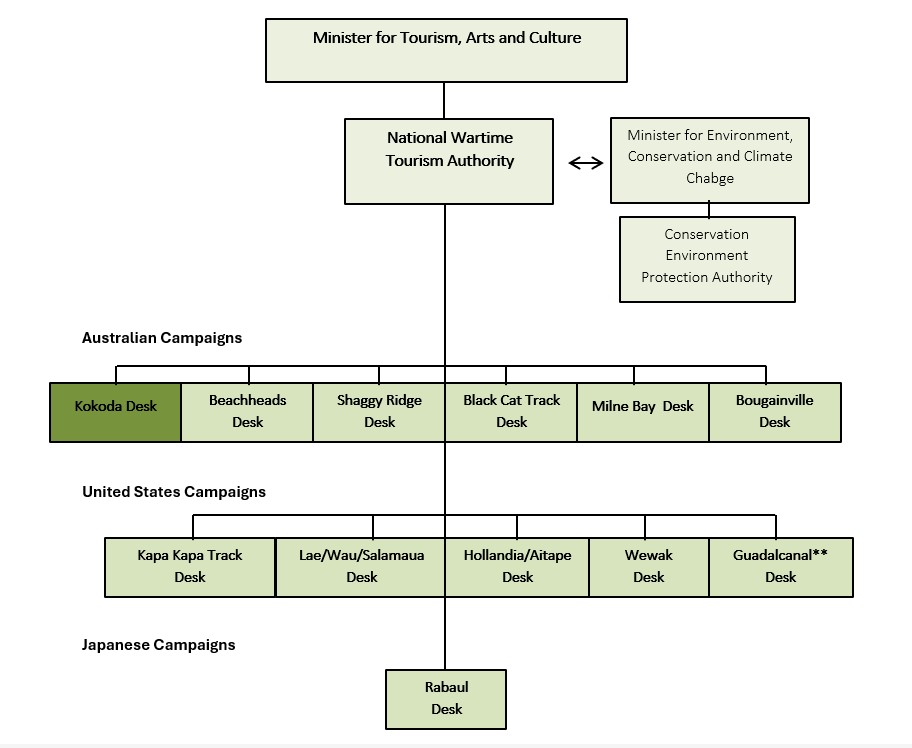
Conclusion
Papua New Guinea has the potential to be a high-value, world-class pilgrimage tourism destination but it must address negative perceptions regarding safety and reliability – particularly after the ‘Black Cat Track’ assaults in 2013. This will require a focused investment in national marketing and support for the development of niche adventures such as wartime pilgrimages, eco-trekking, diving, surfing, fishing. white-water rafting, caving, birdwatching, and culture.
People who participate in these niche adventure activities are generally more aware of the sensitivities of culture and environment and do not expect 5-star accommodation and service – they are also more tolerant of ‘surprises’ that are often experienced in the ‘land of the unexpected’.
The first step in ensuring pilgrimage tourism is developed on a sustainable basis is to establish organisations and procedures that deliver shared benefits to local communities.
Recommendation
PNG National Executive Council:
- Disband the current Kokoda Track (Special Purpose) Authority;
- Transfer legal responsibility for the Kokoda Trail from the Minister for Provincial and Local Level Government to the Minister for Tourism, Arts, and Culture;
- Use the provisions of their Lands Act to acquire the gazetted area of the138 km Kokoda Trail as a national tourism assett;
- Approve the establishment of a Kokoda Trail Management Authority;
- Support the establishment of a Joint Agreement for Pilgrimage Tourism with Australia; and
- Proclaim ‘Kokoda Day’ as a National Day of Commemoration.
Related Articles
- The Rise, Fall and Future of Pilgrimage Tourism across the Kokoda Trail
- The Kokoda Trail: 10 Essential Facts
- Funding Proposal for a Kokoda Trail Military Heritage Master Plan
- Proposed Joint Understanding for Commemoration of the Share Wartime Heritage between PNG and Australia
- The Kokoda Trail: Environment Vs Tourism
- Response to the Mid-Term Review of the Kokoda Initiative Second Joint Understanding
- Review of the Kokoda Initiative Master Plan
- The Fallacy of World Heritage for the Kokoda Trail
- The Fallacy of a ‘Lost Battlefield’ on the Kokoda Trail
- Database Evaluation of the Kokoda Tourism Industry: 2003-2019
- The Kokoda Trail Villager
- The Kokoda Trekker
- Kokoda Villagers Need Charity To
- Owers Corner: How to Convert a Memorial Junkyard into PNGs No1 Tourism Destination
- Marketing Strategy for Kokoda Pilgrimage Tourism
- Official Name of the Kokoda Trail
[i] Michael Pender, Military Heritage Architect, HPA Projects
[ii] Pilgrimages: Journeys of Meaning. Peter Stanford. Thames & Hudson
[iii] The Camino de Santiago is a Christian pilgrimage in Spain that roughly 350,000 people complete every year. The pilgrimage has a long history going back to the 8th century.
[iv] Parliament of a Thousand Tribes. Osmar White. London : Heinemann, 1965
[v] ‘Indifference, Brett Caldwell. https://www.griffithreview.com/articles/indifference/
Yesterday . . .
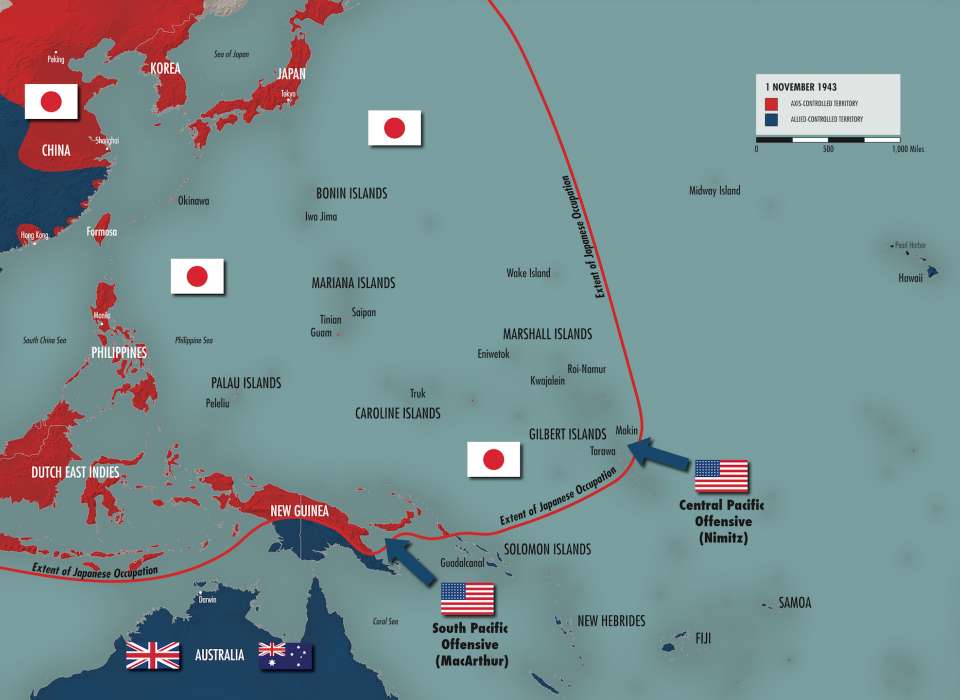
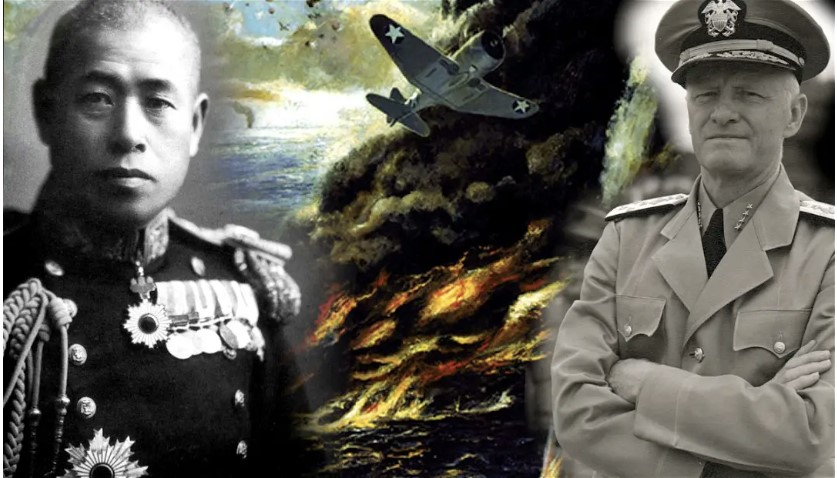
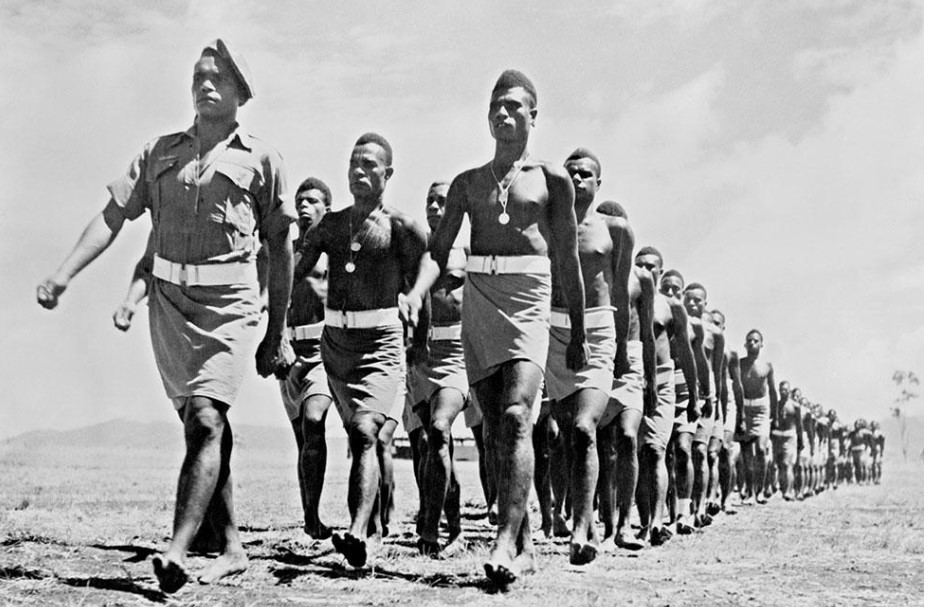
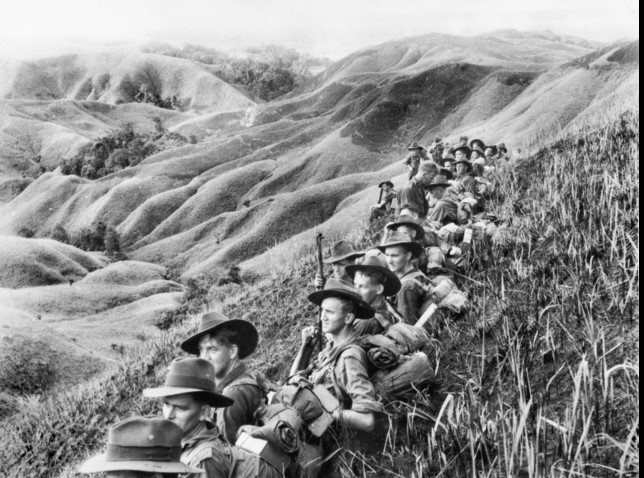
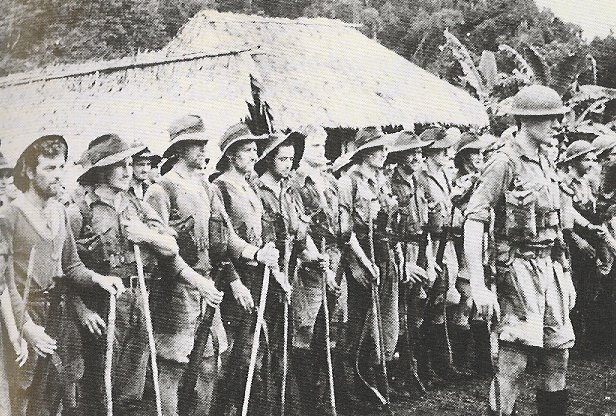
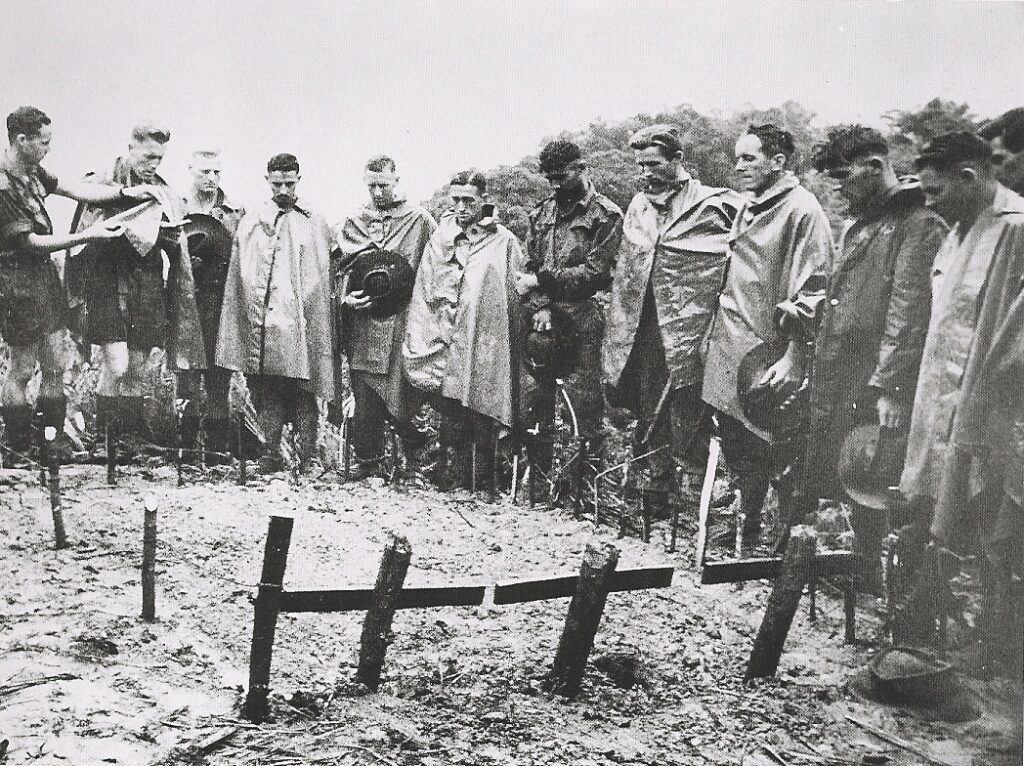
Today . . .
